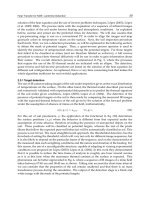Developments in Heat Transfer Part 15 potx
Bạn đang xem bản rút gọn của tài liệu. Xem và tải ngay bản đầy đủ của tài liệu tại đây (6.52 MB, 40 trang )
Thermal Modelling for Laser Treatment of Port Wine Stains
549
affects the highest temperature possible in the PWS layer and the evenness of the
temperature distribution over the PWS layer. A much higher possible temperature in PWS is
achieved for the shorter 585 nm laser than that for the longer 595 nm laser. The longer 595
nm laser, however, produces a much more even heating over the PWS layer. This can be
more clearly demonstrated in the case of a thicker PWS layer as shown in Figure 12b.
(a) Wavelength: 585nm (b) Wavelength: 595nm
Fig. 11. Temperature distributions within the skin at the end of 1.5 ms laser irradiation.
(PWS layer thickness: 200 μm, laser fluence: 6 J/cm
2
, with CSC)
0 100 200 300 400 500 600
20
40
60
80
100
120
Temperature (
o
C
)
Depth ( μm)
585nm
595nm
0 100 200 300 400 500 600
20
40
60
80
100
120
Temperature (
o
C
)
Depth ( μm)
585 nm
595 nm
Wavelength
(a) 200 μm thick PWS layer (b) 300 μm thick PWS layer
Fig. 12. Temperature distribution along the tissue depth direction at the spray center for two
wavelengths (585 and 595nm): PWS layer thickness (a) 200 μm and (b) 300 μm. (Laser
fluence: 6 J/cm
2
, pulse duration: 1.5 ms, with CSC)
5.4 Effect of laser pulse duration
The pulse duration of the laser beam is another important parameter that needs to be
carefully chosen in clinic practice. Figure 13 shows the calculated temperature distributions
within the skin at the end of laser irradiation for three pulse durations: 1.5 ms (a), 10 ms (b)
and 40ms (c), respectively. The laser fluence is 6 J/cm
2
. The comparison of the central
temperature profile within skin for three cases is given correspondingly in Figure 13d.
Developments in Heat Transfer
550
(a) Pulse duration: 1.5 ms (b) Pulse duration: 10 ms
0 100 200 300 400 500 600
20
40
60
80
100
120
Temperature (
o
C
)
Depth ( μm)
1.5ms
10ms
40ms
Pulse duration
(c) Pulse duration: 40 ms (d) Central temperature profile
Fig. 13. Calculated temperature distributions within the skin at the end of laser irradiation
for three pulse durations: (a) 1.5 ms, (b) 10 ms and (c) 40 ms; (d) Comparison of the central
temperature profiles for three pulse durations. (Laser fluence: 6 J/cm
2
with CSC)
Inspecting these plots finds immediately that the peak temperature of the PWS layer at the
end of laser irradiation shows a continuous reduction, from 105 °C to 73 °C as the pulse
duration increases from 1.5 ms to 40 ms. In the case of a short pulse duration (e.g., 1.5 ms),
the PWS layer is heated up quickly at the end of laser irradiation with little heating of the
neighbor dermal tissue. A significant portion of the PWS layer is heated up over the critical
coagulation temperature of 70 °C. When the pulse duration increases to 40 ms, not only the
peak temperature of the PWS layer reduces to a lower value, the percentage of the PWS
layer that is above the critical coagulation temperature is also significantly reduced to a
smaller portion. Meanwhile, the neighbor dermal tissue is significantly heated up to close to
the coagulation temperature, which may lead to the damage of the healthy tissues. Such a
variation in the peak temperature of the PWS with pulse duration can be understood by
considering the combined effect of the laser heating and heat conduction of the heated PWS
to the neighbor colder dermis. As the laser heating prolongs over a long pulse, the heat
conduction from the heated PWS layer to the surrounding colder dermal tissues prevents a
further increase in the PWS temperature and thus reduces the peak PWS temperature. A
longer laser heating time is also associated with more energy through conduction into the
surrounding tissues, leading to continuous increase in the temperature of the dermal tissues.
In clinic practice of laser PWS, a short laser pulse is usually preferred, except for the cases
with extremely large blood vessels. For that case, however, a better model is needed to
provide more quantitative description of the laser surgery process of PWS.
Thermal Modelling for Laser Treatment of Port Wine Stains
551
6. Conclusion and future work
In this chapter, we present a brief review of thermal modelling of the treatment of port wine
stains with the pulsed dye laser. We show that laser treatment of port wine stains is
primarily a thermal issue involving both radiative energy transport within the tissue during
laser irradiation and tissue heat conduction during and after laser irradiation. Based on
simplified skin models that reduce the complex anatomic structure of skins to simple layer
structures, the process can be successfully simulated by solving the corresponding radiative
energy transport with the multi-layer Monte-Carlo method and the heat conduction
equation with traditional numerical methods. We have used a simple multi-layer
homogeneous model to illustrate the basic thermal characteristics of laser treatment of PWS.
We also demonstrated that the model can be used to make selections of the laser parameters
such as wavelength and pulse width in clinical practice. Quantitative information for critical
surface cooling technique, CSC, is also presented and included in our model.
Although great progresses have been achieved in both clinic practice and physical
understanding of laser PWS after four decades’ efforts, many issues remain. Clinically, the
present protocol of PDL-based lasers could significantly eliminate the PWS vessels, but only
less than 20% of complete clearance of the PWS has been achieved (Kelly et al., 2005).
Recurrence has been observed with a rate up to 50% after five years (Orten et al., 1996). All
these suggest a lack of fundamental understanding of the PWS destruction mechanisms in
the present laser PWS process. From the modeling point of view, neither the multi-layer
homogeneous model nor the discrete blood vessel model provides accurate representation
of the real and complex anatomic configuration of the PWS vessels. Attempts to construct
realistic PWS structure based on computer-reconstructed biopsy from PWS patients had
only limited success (Pfefer et al., 1996). New models are desired that should combine the
simplicity of the multi-layer homogeneous model while take into account the detailed effect
of complex PWS configurations. In addition, quantitative predictions of the temperature
change of the PWS in the laser treatment require accurate optical and thermal properties of
PWS, which are scarce at the moment.
The ultimate objective of any model for laser PWS is to accurately predict the thermal
damage after the laser irradiation. The existing PWS damage model is a pure thermal model
based on simple Arrhenius rate process integral (Pearce & Thomsen, 1995). The model does
not take into account the photochemical and photomechanical effect of laser on skin tissues
and blood vessels. Recent experimental evidence suggests that the vessel damage in laser
PWS is a multi-time scale phenomenon. The collateral damage of blood vessels in laser PWS
is due to accumulative result of early photothermal effect and later photochemical and
photomechanical effect. The recurrence of PWS involves a time scale that may last to more
than five years. Active researches are being conducted to understand these long term
phenomena in laser PWS.
7. Acknowledgments
We like to acknowledge valuable discussions with Drs. Y.X. Wang and Z.Y. Ying at Laser
Cosmetic Centre of 2
nd
Hospital of Xi’an Jiaotong University. Special thanks to Prof. Guo
Lie-jin, Prof. Chen Bin, Prof. Wang Yue-she, Dr. Zhou Zhi-fu and Dr. Wu Wen-juan for their
help to the project. G X. Wang thanks the support of “Changjiang Scholar” program of
Education Ministry of China. The work is supported in part by the special fund from the
State Key Laboratory of Multiphase Flow in Power Engineering at Xi’an Jiaotong University.
Developments in Heat Transfer
552
8. References
Aguilar, G.; Diaz, S.H.; Lavernia, E.J. & Nelson, J.S. (2002). Cryogen spray cooling efficiency:
improvement of port wine stain laser therapy through multiple-intermittent
cryogen spurts and laser pulses. Lasers in Surgery and Medicine, Vol.31, No.4, (July
2002), pp. 27-35, ISSN 0196-8092
Aguilar, G.; Wang, G X. & Nelson, J.S. (2003a). Effect of spurt duration on the heat transfer
dynamics during cryogen spray cooling. Phys Med Biol, Vol.48, No.14, (July 2003),
pp. 2169-2181, ISSN 0031-9155
Aguilar, G.; Wang, G X. & Nelson, J.S. (2003b). Dynamic Cooling Behavior during Cryogen
Spray Cooling: Effects of Spurt Duration and Spray Distance. Lasers in Surgery and
Medicine, Vol. 32, No.2, (February 2003), pp. 152-159, ISSN 0196-8092
Anderson, R.R. (1997). Laser-tissue interaction in dermatology, In: Lasers in cutaneous and
aesthetic surgery, K.A. Arndt (Ed.), pp. (26-51), Lippincott Williams and Wilkins,
ISBN 0316051772, Boston, Massachusetts, USA
Anderson, R.R. & Parrish, J.A. (1983). Selective photothermolysis: precise microsurgery by
selective absorption of pulsed radiation. Science, Vol.220, No.4596, (April 1983), pp.
524–527, ISSN 0036-8075 (Print), 1095-9203 (Online)
Alora, M. B. T. & Anderson, R. R. (2000). Recent developments in cutaneous lasers. Lasers in
Surgery and Medicine. Vol.26, No.2, (April 2000), pp. 108–118, ISSN 0196-8092
Alper, J.C. & Holmes, L.B. (1983). The incidence and significance of birthmarks in a cohort of
4641 newborns. Pediatr Dermatol., Vol. 1, No.1, (July 1983), pp. 58-68, ISSN 1525-
1470 (Online)
Baumler, W.; Vogl, A.; Landthaler, M.; Waner, M. & Shafirstein, G. (2005). Port wine stain
laser therapy and the computer-assisted modeling of vessel coagulation using the
finite elements method. Medical Laser Application, Vol.20, No.4, (December 2005),
pp. 247-254, ISSN 1615-1615
Brannon, H. (April 2007). Skin Anatomy, In: About.com, 10.04.2011, Available from:
Dixon, J.A.; Huether, S.; & Rotering, R. (1984). Hypertrophic scarring in argon laser
treatment of port wine stains. Plast Reconstruct Surg, Vol.73, No.5, (May 1984), pp.
771-780, ISSN 0032-1052 (Print), 1529-4242 (Online)
Franco W.; Wang, G X.; Nelson, J.S. & Aguilar, G. (2004). Radial Heat Transfer Dynamics
during Cryogen Spray Cooling. Proceedings of IMECE 2004, IMECE2004-59609,
ASME, ISBN 0-7918-4711-X
Franco, W.; Liu, J.; Wang, G X.; Nelson, J.S. & Aguilar, G. (2005). Radial and temporal
variations in surface heat transfer during cryogen spray cooling. Phys Med Biol,
Vol.50, No.2, (January 2005), pp. 387-397, ISSN 0031-9155
Gemert, M.J.C. van & Hulsbergen, J.P.H. (1981). A model approach to laser coagulation of
dermal vascular lesions. Arch Dermatol Res, Vol.270, No.4, (February 1981), pp. 429-
439, ISSN: 0340-3696 (Printed) 1432-069X (Online)
Gemert, M.J.C. van; de Kleijn, W.J.A. & Hulsbergen J.P.H. (1982). Temperature behaviour of
a model port wine stain during argon laser coagulation. Phys Med Biol, Vol.27, No.9,
(September 1982), pp. 1089–1104, ISSN 0031-9155
Thermal Modelling for Laser Treatment of Port Wine Stains
553
Gemert, M.J.C. van; Welch, A.J.; & Amin, A.P. (1986). Is there an optimal laser treatment for
port wine stains? Lasers in Surgery and Medicine, Vol.6, No.1, (January 1986), pp. 76-
83, ISSN 0196-8092
Gemert, M.J.C. van; Welch, A.J.; Tan, O.T.; & Parrish, J.A. (1987). Limitations of carbon
dioxide lasers for treatment of port-wine stains. Arch Dermatol, Vol.123, No.1,
(January 1987), pp. 71-73, ISSN (Printed): 0340-3696 (Online): 1432-069X
Gemert, M.J.C. van; Welch, A.J.; Pickering, J.W. & Tan, O.T. (1995). Laser Treatment of Port
Wine Stains, In: Optical-Thermal Response of laser-Irradiated Tissue, A.J. Welch &
M.J.C. van Gemert, (Ed.), 789-829, Plenum Press, ISBN 0-306-44926-9, New York
Gemert, M.J.C. van; Smithies, D.J.; Verkruysse, W.; Milner, T.E. and Nelson, J.S. (1997).
Wavelengths for port wine stain laser treatment: influence of vessel radius and skin
anatomy. Phys Med Biol, Vol.42, No.1, (January 1997), pp. 41–50, ISSN 0031-9155
Gilchrest, B.A.; Rosen, S. & Noe, J.M. (1982). Chilling port wine stains improves the response
to argon laser therapy. J Plast Reconstr Surg, Vol.69, No.2, (February 1982), pp. 278-
283, ISSN 0032-1052 (Print), 1529-4242 (Online)
Hammes, S. & Raulin, C. (2005). Evaluation of different temperatures in cold air cooling
with pulsed-dye laser treatment of facial telangiectasia. Lasers in Surgery and
Medicine, Vol.36, No.2, (February 2005), pp. 136–140, ISSN 0196-8092
Ishimaru, A. (1989). Diffusion of light in turbid media. Appl Opt, Vol.28, No.12, (June 1989),
pp. 2210-2215, ISSN 1559-128X (Print) 2155-3165 (Online)
Jacques, S.L. & Wang, L.H. (1995). Monte Carlo Modeling of Light Transport in Tissues, In:
Optical-Thermal Response of laser-Irradiated Tissue, A.J. Welch & M.J.C. van Gemert,
(Ed.), 73-100, Plenum Press, ISBN 0-306-44926-9, New York
Jia, W.C.; Aguilar, G.; Wang, G X. & Nelson, J.S. (2004). Heat transfer dynamics during
cryogen spray cooling of substrate at different initial temperatures. Phys Med Biol,
Vol. 49, No.23, (December 2004), pp. 5295-5308. ISSN 0031-9155
Jia, W.; Aguilar, G.; Verkruysse, W.; Franco, W. & Nelson, J.S. (2006). Improvement of port
wine stain laser therapy by skin preheating prior to cryogen spray cooling: a
numerical simulation. Lasers in Surgery and Medicine, Vol.38, No.2, (February 2006),
pp. 155-162. ISSN 0196-8092
Jia, W.C.; Choi, B.; Franco, W.; Lotfi, J.; Majaron, B.; Aguilar, G.; & Nelson, J.S. (2007).
Treatment of cutaneous vascular lesions using multiple-intermittent cryogen spurts
and two-wavelength laser pulses: numerical and animal studies. Lasers in Surgery
and Medicine, Vol.39, No.6, (July 2007), pp. 494-503, ISSN 0196-8092
Keijzer, M.; Pickering, J.W. & van Gemert, M.J.C. (1991). Laser beam diameter for port wine
stain treatment. Lasers in Surgery and Medicine, Vol.11, No.6, (October 1991), pp. 601-
605, ISSN 0196-8092
Kelly, K.M.; Choi B.; McFarlane, S; et al. (2005). Description and analysis of treatments for
port-wine stain birthmarks. Arch Facial Plast Surg, Vol.7, No.5, (October 2005), pp.
287—94, ISSN 1521-2491
Kienle, A. & Hibst, R. (1995). A new optimal wavelength for treatment of port wine stains?
Phys Med Biol, Vol.40, No.10, (October 1995), pp. 1559-76, ISSN 0031-9155
Kienle, A. & Hibst, R. (1997). Optimal parameters for laser treatment of leg telangiectasia.
Lasers in Surgery and Medicine, Vol.20, No.3, (December 1998), pp. 346–353, ISSN
0196-8092
Developments in Heat Transfer
554
Lahaye C.T.W. & van Gemert, M.J.C. (1985). Optimal laser parameters for port wine stain
therapy: a theoretical approach. Phys Med Biol, Vol.30, No.6, (June 1985), pp.573-87,
ISSN 0031-9155
Lanigan, S. W. (2000). Lasers in Dermatology, Springer, London, ISBN 1852332778
Li, D.; He, Y.L.; Liu, Y.W. & Wang, G X. (2007a), Numerical analysis of cryogen spray
cooling of skin in dermatologic laser surgery using realistic boundary conditions.
Proceedings of 22th Int. Congress Refrigeration conference, (July) 2007, Beijing, China
Li, D.; He, Y.L.; Wang, G X.; Xiao, J. & Liu, Y.W. (2007b), Numerical analysis of cold injury
of skin in cryogen spray cooling for dermatologic laser surgery. Proceedings of 2007
ASME International Mechanical Engineering Congress, IMECE2007-43876, Nov. 2007,
Seattle, Washington, ISBN 0-7918-4302-5
Li, D.; Wang, G X. & He, Y.L. (2011), Criteria for section of voxel size and photon number in
Monte Carlo Simulation, to be submitted
Lucassen, G.W.; Svaasand, L.O.; Verkruysse, W. & van Gemert, M.J.C. (1995). Laser energy
threshold for thermal vascular injury in a port wine stain skin model. Laser Med Sci,
Vol.10, No.4, (December 1995), pp. 231-234, 0268-8921 (Print), 1435-604X (Online)
Lucassen, G.W.; Verkruysse, W.; Keijzer, M. & van Gemer, M.J.C. (1996). Light distribution
in a port wine stain model containing multiple cylindrical and curved blood
vessels. Lasers in Surgery and Medicine, Vol.18, No.4, (April 1996), pp. 345-357, ISSN
0196-8092
Majaron, B.; Verkruysse, W.; Kelly, K.M.; & Nelson, J.S. (2001). Er:YAG laser skin
resurfacing using repetitive long-pulse exposure and cryogen spray cooling: II.
theoretical analysis. Lasers in Surgery and Medicine, Vol.28, No.2, (February 2001),
pp. 131-137, ISSN 0196-8092
Miller, I.D. & Veith, A. R. (1993). Optical modelling of light distributions in skin tissue
following laser irradiation. Lasers in Surgery and Medicine, Vol.13, No.5, (May 1993),
pp. 565–571, ISSN 0196-8092
Nelson, J.S.; Milner, T.E.; Anvari, B.; Tanenbaum, B.S.; Kimel, S.; Svaasand, L.O.; & Jacques,
S.L. (1995). Dynamic epidermal cooling during pulsed laser treatment of port-wine
stain: A new methodology with preliminary clinical evaluation. Arch Dermatol,
Vol.131, No.6, (June 1995), pp. 695–700, ISSN 1538-3652 (Print), 0003-987X (Online)
Niemz, M.H.; (1996). Laser-Tissue Interactions: Fundamentals and Applications, Springer Berlin
Heidelberg, New York. Hardcover, ISBN 978-3-540-40553-5 Softcover, ISBN 978-3-
540-72191-8
Orten S.S.; Waner M.; Flock S.; Roberson P.K.; Kincannon J. (1996). Port wine stains: an
assessment of five years of treatment. Arch Otolaryngol Head Neck Surg, Vol.122,
No.11, (November 1996), pp. 1174-9. ISSN 0886-4470 (Print) 1538-361X (Online)
Pearce, J. & Thomsen, S. (1995). Rate Process Analysis of Thermal Damage, In: Optical-
Thermal Response of laser-Irradiated Tissue, A.J. Welch & M.J.C. van Gemert, (Ed.),
561-606, Plenum Press, ISBN 0-306-44926-9, New York
Pfefer, T.J.; Barton, J.K.; Chan, E.K.; Ducros, M.G.; Sorg, B.S.; Milner, T.E.; Nelson, J.S. &
Welch, A.J. (1996). A three dimensional modular adaptable grid numerical model
for light propagation during laser irradiation of skin tissue. IEEE Journal of Selected
in Quantum Electronics, Vol.4, No.4, (December 1996), pp. 934–942, ISSN 1077-260X
Thermal Modelling for Laser Treatment of Port Wine Stains
555
Pfefer, T.J.; Smithies, D.J.; Milner, T.E.; van Gemert, M.J.C.; Nelson, J.S. & Welch, A.J. (2000).
Bioheat transfer analysis of cryogen spray cooling during laser treatment of Port
Wine Stains. Lasers in Surgery and Medicine, Vol.26, No.2, (February 2000), pp. 145-
157, ISSN 0196-8092
Pickering, J.W.; Butler, P.H.; Ring, B.J. & Walker, E.P. (1989). Computed temperature
distributions around ectatic capillaries exposed to yellow (578 nm) laser light. Phys
Med Biol, Vol.34, pp. 1247-1258, ISSN 0031-9155
Pickering, J.W. & van Gemert, M.J.C. (1991). 585 nm for the laser treatment of port wine
stains: A possible mechanism. Lasers in Surgery and Medicine, Vol.11, No.6, (June
1991), pp. 616-618, ISSN 0196-8092
Pikkula, B.M.; Torres, J. H.; Tunnell, J.W. & Anvari, B. (2001). Cryogen spray cooling: effects
of droplet size and spray density on heat removal. Lasers in Surgery and Medicine,
Vol. 28, No.2, (February 2001), pp. 103-112, ISSN 0196-8092
Shafirstein, G.; Bäumler, W.; Lapidoth, M.; Ferguson, S.; North, P.E. & Waner, M. (2004). A
New Mathematical Approach to the Diffusion Approximation Theory for Selective
Photothermolysis Modeling and Its Implication In Laser Treatment of Port-Wine
Stains. Lasers in Surgery and Medicine, Vol. 34, No.4, (April 2004), pp. 335–347, ISSN
196-8092
Shafirstein, G. & Buckmiller, L.M.; Waner, M. & Bäumler, W. (2007). Mathematical modeling
of selective photothermolysis to aid the treatment of vascular malformations and
hemangioma with pulsed dye laser. Lasers Med Sci, Vol.22, No.2, (June 2007), pp.
111-118, ISSN 0268-8921(Print), 1435-604X (Online)
Smithies, D.J. & Butler, P.H. (1995). Modelling the distribution of laser light in port-wine
stains with the Monte Carlo method. Phys Med Biol, Vol.40, No.5, (May 1995), pp.
701-33, ISSN 0031-9155
Tan, O.T.; Morrison, P. & Kurban, A.K. (1990). 585 nm for the treatment of port-wine stains.
Plast Reconstr Surg Med, Vol.86, No.6, (December 1990), pp. 1112-1117, ISSN 0032-
1052 (Print), 1529-4242 (Online)
Tunnell, J.W.; Nelson, J.S.; Torres, J.H.; & Anvari, B. (2000). Epidermal protection with
cryogen spray cooling during high fluence pulsed dye laser irradiation: an ex vivo
study. Lasers in Surgery and Medicine, Vol.27, No.4, (April 2000), pp. 373-383, ISSN
0196-8092
Tunnell, J.W.; Wang, L.V. & Anvari, B. (2003). Optimum pulse duration and radiant
exposure for vascular laser therapy of dark portwine skin: A theoretical study. Appl
Opt, Vol.42, No.7, (July 2003), pp. 1367–1378, ISSN 1559-128X (Print), 2155-3165
(Online)
Verkruysse, W.; Pickering, J.W.; Beek, J.F.; Keijzer, M.; van Gemert, M.J.C. (1993). Modeling
the effect of wavelength on the pulsed dye laser treatment of port wine stains. Appl
Opt, Vol.32, No.4, (February 1993), pp. 393–8, ISSN 1559-128X (Print), 2155-3165
(Online)
Wang, L.H.; Jacques, S.L. & Zheng, L.Q. (1995). MCML-Monte Carlo modeling of light
transport in multi-layered tissues. Comp Meth Prog Biol, Vol.47, No.2, (July 1995),
pp. 131-146, ISSN 0169-2607
Wilson, B.C. & Adam, G. (1983). A Monte-Carlo model for the absorption and flux
distribution of light in tissue. Med Phys, Vol.10, No.6, (December 1983), pp. 824-830,
ISSN 0094-2405
Developments in Heat Transfer
556
Zhou, Z.; Xin, H.; Chen, B. & Wang, G X. (2008a). Theoretical Evaporation Model of a Single
Droplet in Laser Treatment of PWS in Conjunction with Cryogen Spray Cooling.
Proceedings of 2008 ASME Summer Heat Transfer Conference, HT2008-56063, Aug. 10-
14, 2008, Hyatt Regency Riverfront, Jackonsville, Florida, ISBN: 978-0-7918-4849-4
Zhou, Z.; Xin, H.; Chen, B. & Wang, G X. (2008b). Single Droplet Evaporation Model in
Laser Treatment of PWS in Conjunction with Cryogen Spray Cooling. Proceedings of
2008 International Conference on Bio-Medical Engineering and Informatics, Vol. 1, pp.
551-556, May 28-30, Sanya, Hanan, China, ISBN: 978-0-7695-3118-2
28
Study of the Heat Transfer
Effect in Moxibustion Practice
Chinlong Huang and Tony W. H. Sheu
Dept of Engineering Sciences and Ocean Engineering,
National Taiwan University, No. 1, Sec. 4, Roosevelt Road, Taipei, 10617
Taiwan
1. Introduction
“First you use the needle (acupuncture), then the fire (moxibustion), and finally the herbs”
(Tsuei, 1996) has been well known in traditional Chinese medicine (TCM). In fact, moxibustion
has played an important role in Asia for many years (Zhang, 1993). In Huang Di Nei Jing
(Maoshing (translator), 1995), we can find that when needle can’t do a job, moxa is a better
choice. Moxibustion rather than acupuncture was commonly known to be able to alleviate
pains due to some severe diseases, manifested by vacuity cold and Yang deficiency. In
clinical studies, many experiments have confirmed that moxibustion is capable of enhancing
immunity, improving circulation, accommodating nerve, elevating internal secretion and
adjusting respiration, digestion and procreation et al. (Wu et al., 2001; Liu, 1999). However,
moxibustion has not been accepted as the modern therapy because of the lack of standard
practice procedures. In addition, moxibustion is subject to the danger of scalding patients.
More effort needs therefore to be made so as to increase our knowledge about the moxibustion
and, hopefully, these research endeavors can be useful for the future instrumentation and
standardization of the moxibustion by some emerging modern scientific techniques.
The existing moxibustion techniques can be separated into the direct and indirect moxibustion
therapies. In direct moxibustion, the ignited cone-shaped moxa is normally placed on the
skin surface near acupoints (Fig. 1(a)). Direct moxibustion can be further categorized into
the scarring and non-scarring two types. During the scarring moxibustion, the ignited moxa
is placed on the top of an acupoint till a time it burns out completely. This moxibustion type
may lead to a localized scarring or blister. In non-scarring moxibustion, moxa cone is also
burned directly on the skin. Such an ignited moxa will be removed when it may cause an
intense pain (moxa temperature should be under 60 ºC). Usually, this treatment will result
in a small red circular mark on the local area of the skin surface.
Indirect moxibustion becomes more popular currently because of its lower risk of leading to
pain or burning. A common way of administering the therapeutic properties of moxibustion
is to place, for example, a piece of ginger, garlic, salt or pepper in between the burning moxa
and the skin. One can also ignite a moxa stick, which is placed at a location that is closed to
but not in contact with the proper acupoint (about 2cm to skin surface normally), for several
minutes until the color of the skin surface near this acupoint turns red.
Developments in Heat Transfer
558
burning
moxa
calf section
burning
moxa
calf
section
needle
needle
handle
(a) (b)
Fig. 1. Schematic of the moxibustions. (a) Direct moxibustion therapy; (b) Warm needle
moxibustion therapy
Another indirect moxibustion involves the use of needles and moxa. One needle, along
which there is a moxa, is inserted into the skin near an acupoint. The moxa cone placed on
the inserted needle is then ignited. The heat generated from the burning moxa will propagate
through the needle and transfers to the acupoint by heat conduction. During the treatment,
a dried moxa is in contact with the handle of the acupuncture needle after the needle being
inserted into the acupuncture point. This is followed by igniting the moxa and keeps it
burning (Fig. 1(b)). Typically, the distance between the skin surface and the burning moxa
stick is about 2 cm. Heat will be conducted from the needle handle to the needle itself and,
finally, to the surrounding tissues. This acupuncture design with a burning moxa can result
in a certain temperature gradient across the needle and enhances thus the Seebeck effect
(Cohen, 1997). In Chinese medicine theory, this method is highly recommended for use to
the patients with vacuity cold and wind damp (Wiseman, 1998) because of its functions of
warming the meridians and promoting the qi- and blood-flow. This therapy is also
applicable to release the cold-damp syndrome for the patients with rheumatoid arthritis
(Li, 1999). The other technique is called as the fire needle, which involves holding the needle
in a lamp flame until it becomes very hot. Afterwards, the needle is inserted to the
appropriate depth in the body quickly and it will be removed later on (Unschuld, 1988). In
comparison with the fire needle, the warming needle permits a longer retention and a
gentler heating.
In the present study, our aim is to study two types of the moxibustion effect, which are the
direct moxibustion and the warm needle moxibustion therapy. The acupoint GB 38 shown
in Fig. 2 is one of the acupoints in gall bladder (GB) meridian, which has an association with
the hemicrania and joint ache. Figure 3 shows the axial image of the right leg for the GB38
acupoint (Courtesy of Yang (1997)). At the calf section, the number of capillaries near the GB
acupoints is greater than those at the other parts of the body (Fei, 2000). Also, the distances
between the three acupoints GB37-GB38 and GB38-GB39 have about an inch. Therefore, the
acupoint GB38 was also the focus of other investigations (Sheu and Huang, 2008; Huang
and Sheu, 2008; Huang and Sheu, 2009).
Study of the Heat Transfer Effect in Moxibustion Practice
559
Fig. 2. Schematic of the stomach, gall bladder and bladder meridians. Note that GB38 is the
acupoint under current investigation
(Chang, 1999)
Fig. 3. One axial image of the right leg that contains the GB38 acupoint (Courtesy of Yang
1997). Heaven, man and earth are three depths beneath of the skin surface
Developments in Heat Transfer
560
2. Materials and methods
Heat transfer process will be modelled by solving the energy conservation equation. In this
study, the energy equation cast in the following form for the total enthalpy will be
employed
0
()
()
h
kT
t
ρ
∂
=∇⋅ ∇
∂
(1)
In the above equation, h
0
, k,
ρ
and T denote the internal energy, thermal conductivity,
density, and temperature, respectively.
Simulation of equation (1) will be carried out by employing the commercially available finite
volume package, namely, CFDRC (CFD-ACE-GUI, 2003). This software package provides
the modules CFD-GEOM for grid generation, CFD-ACE
+
for solution solver, and CFD-
VIEW for post-processing. A convenient graphical user interface (GUI) is also available for
us to specify the physical properties of the medium under investigation, and the
specification of the boundary and initial conditions. In CFD-ACE
+
solver, the finite volume
method employed together with the algebraic multigrid method and the conjugate gradient
squared solution solver accelerates calculation. In this study, the central difference scheme is
chosen to approximate the parabolic type partial differential equation.
GB38
calf
tibia
fibula
GB38
(a) (b)
Fig. 4. (a) The generated surface meshes for the investigated calf section; (b) The zoom-in
area around GB38
A hybrid mesh, containing the structured- and unstructured-type meshes, shown in Fig. 4, is
generated from a total number of 17,000 nodal points. These mesh points have been
properly distributed so that the predicted solutions can more accurately represent the
Study of the Heat Transfer Effect in Moxibustion Practice
561
physical phenomenon. In all the investigations, calculation of the enthalpy will be
terminated when the residual norms fall below 10
-15
. As the number of the employed nodal
points (with 17,000 nodal points) is increased by 50% (25,500 nodal points), only a negligibly
small difference is seen in the simulated results. On the contrary, when the number of the
mesh points is decreased by 50% (or 8,500 nodal points) the computed difference shows an
apparent difference. Hence the mesh generated by 17,000 nodal points will be employed in
the present simulation.
In order to know the temperature distribution due to the ignited moxa, the IR images are
collected under the almost dark condition. Both of the camera and the subject are kept apart
from the external draft IR source. The room temperature and the relative humidity are kept
at 22 ± 0.1 ºC and 60 ± 7%, respectively. Thermography is taken using a calibrated IR camera
(ThermaCAM® SC500 from FLIR Systems TM) (ThermaCAM SC500 Operator’s Manual),
which is equipped with a 45°close-up optic. Sensitivity, accuracy and resolution of the
employed camera are kept at 0.07 ºC, ± 2 ºC and 320 × 240 pixels, respectively. The distance
between the camera and the subject under current investigation is 0.1 m. The infrared
images of the subject obtained at a sampling rate of 4 Hz will be directly recorded in the
computer’s hard disk.
calf
tibia
fibula
BC II
BC III
(T
E
=22
o
C)
BC I (T=37
o
C)
BC I (T=60
o
C)
BC II
GB 38
BC I: isothermal BC II: symmetry
BC III: external heat transfer (by convection)
Fig. 5. Schematic of the calf section around the acupoint GB 38 and the specified boundary
conditions
Developments in Heat Transfer
562
3. Results and discussion
In the present study, direct moxibustion and warm needle moxibustion treatments are
described below:
(A) Direct moxibustion therapy
In direct moxibustion therapy, a burned moxa (moxa cone of 1 cm diameter and 1cm length,
made by the dried Artemisia vulgaris leaves with a weight of 100 mg), was placed on
acupoint GB38 shown in Fig. 4. The boundary conditions applied at the calf section with
tibia and fibula are shown in Fig. 5, where BC I, II and III represent the isothermal,
symmetric and heat transfer (by convection) boundary conditions, respectively. In BC III,
the wall subtype is chosen to account for the transfer of heat to/from the external
environment (i.e., the area outside of the computational system) by heat convection. On the
boundary BC III, it is specified by the condition
()
wcEw
qhTT
=
− (2)
where h
c
and T
E
denote the heat transfer coefficient and the environment temperature. The
wall temperature (T
w
) is determined by balancing the heat fluxes between the environment
and the skin surface.
The heat transfer coefficient of the skin surface, specific heat and the density of tissues in the
investigated calf section are denoted as h
c
, Cp
c
and
ρ
c
, respectively. At the normal state, these
coefficients are prescribed respectively with h
c
= 3.7 W/m
2
ºC (Nishi and Gagge, 1970),
Cp
c
= 3,594 J/kgºC (Blake et al., 2000) and
ρ
c
= 1,035 kg/m
3
. The thermal conductivity of the
human tissues is assumed to change with the temperature (T) by the equation k
c
= 0.840419+
0.001403T W/mºC (Mura et al., 2006). The rest of the employed coefficients are tabulated in
the Table 1.
k
s
16 W/m ºC Thermal conductivity of the stainless steel
k
c
0.840419+0.001403T W/m ºC Thermal conductivity of the calf
k
a
0.0299 W/m ºC Thermal conductivity of the air
Cp
s
460 J/kg ºC Specific heat of the stainless steel
Cp
c
3,594 J/kg ºC Specific heat of the calf
Cp
a
1,009 J/kg ºC Specific heat of the air
ρ
s
7,800 kg/m
3
Density of the stainless steel
ρ
c
1,035 kg/m
3
Density of the calf
ρ
a
1.0 kg/m
3
Density of the air
h
s
7.9 W/m
2
ºC Heat transfer coefficient of the stainless steel
h
c
3.7 W/m
2
ºC Heat transfer coefficient of the calf
T
E
22 ºC Environment temperature
Table 1. Summary of the coefficients and the prescribed temperatures in the current
simulation
The predicted temperature on the skin surface is plotted in Fig. 6. The moxa temperature on
the skin surface is specified at 60 ºC (non-scarring direct moxibustion), which is the highest
Study of the Heat Transfer Effect in Moxibustion Practice
563
temperature that our skin can possibly endure, to avoid scarring. On the tibia and fibula,
their temperatures are given to be T= 37 ºC, which is the same as the normal human body
temperature. One can find from the upper and bottom planes of the simulated domain that
the temperature near tibia and fibula has a larger value (Fig. 6). Since moxibustion takes
place at a location near GB38, the area around this acupoint has a higher temperature.
Figure 7 shows the predicted skin surface temperature that is distributed in a form similar to
the experimentally measured temperature by IR image.
59
57
55
53
51
49
47
45
43
41
39
37
35
Fig. 6. The predicted skin surface temperature contours subject to the moxibustion
60
56
52
48
44
40
36
32
28
24
57
47
37
27
(a) (b)
Fig. 7. Comparison of the predicted and measured temperatures. (a) Measured by the IR
image recording system; (b) Predicted by the numerical simulation
Developments in Heat Transfer
564
A
B
heaven
man
earth
59
57
55
53
51
49
47
45
43
41
39
37
35
A
B
0
0.02 0.04
0.06
depth (m)
310
320
330
T
(a) (b)
Fig. 8. (a) The predicted temperature contours on the cutting plane that passes through the
acupoint GB38 when the moxa temperature on the skin surface is 60 ºC; (b) The predicted
temperature profile along the line connected by two points A and B shown in Fig. 8(a). The
“heaven”, “man” and “earth” represent three depths of the investigated acupoints,
respectively
In TCM, there is one concept, “When using acupuncture, shallow position treats diseases
nearby; deep position treats diseases far away”. Huang Di Nei Jing (Maoshing (translator),
1995) supported the similar concept that at the same acupoint shallow position treats mild
diseases; deep position treats severe diseases. This enlightens that at the same acupoint
different depths have different effects and even have an association with different diseases.
For this reason, this study makes an effort to get the temperature distributions at different
depths. Figure 8 (a) shows the temperature contours predicted at the plane of the acupoint
GB38 for the case that the moxa temperature on the skin surface is 60 ºC. From Fig. 8 (b), one
can see the predicted temperature profile along a line that is connected by two nodes A and
B. For the acupoints “heaven”, “man” and “earth”, they have three different depths at a
location in between the skin surface and the associated connective tissue. When the moxa
temperature is controlled at 60 ºC, which is the temperature considered in the case of non-
scarring moxibustion, the temperatures at the “heaven” (~ 0.5 cm beneath of the skin
surface), “man” (~ 1.0 cm beneath of the skin surface) and “earth” (~ 1.5 cm beneath of the
skin surface) are predicted as
60
heaven
T = 47.8 ºC,
60
man
T = 41.7 ºC and
60
earth
T = 39.0 ºC. From the
skin surface to “heaven”, we found that temperature decreases faster (12.2 ºC in between)
than those from the “heaven” to “man” (6.1 ºC in between) and from the “man” to “earth”
(2.7 ºC in between) as well because our body has a bigger thermal capacity than that of the
moxa. As a result, the temperature variation on the side of “heaven” is greater than that
along the “earth”. The relation between the predicted temperature (
T) and the depth (x) can
be expressed as
25283124155206
60 5.31 10 5 10 3 10 7 10 1 10 6 10Txxxxxx
−−−−−−
=− × +× −× +× −× +× (3)
Study of the Heat Transfer Effect in Moxibustion Practice
565
A
B
97
92
87
82
77
72
67
62
57
52
47
42
37
A
B
heaven
man
earth
0 0.02 0.04 0.06
depth (m)
47
67
87
107
T
(a) (b)
Fig. 9. (a) The predicted temperature contours on the cutting plane that passes through the
acupoint GB38 when the moxa temperature on the skin surface is 100 ºC; (b) The predicted
temperature profile along the line connected by two points
A and B shown in Fig. 9(a). The
“heaven”, “man” and “earth” represent three depths of the investigated acupoints,
respectively
A
B
heaven
man
earth
A
B
T
197
187
177
167
157
147
137
127
117
107
97
87
77
67
57
47
37
0 0.02 0.04 0.06
depth (m)
77
127
177
T
(a) (b)
Fig. 10. (a) The predicted temperature contours on the cutting plane that passes through the
acupoint GB38 when the moxa temperature on the skin surface is 200 ºC; (b) The predicted
temperature profile along the line connected by two points
A and B shown in Fig. 10(a). The
“heaven”, “man” and “earth” represent three depths of the investigated acupoints,
respectively
Developments in Heat Transfer
566
We then consider the scarring moxibustion by specifying the moxa temperatures at two
higher temperatures 100 and 200 ºC. The temperatures at three locations are predicted to be
100
heaven
T
= 68.1ºC,
100
man
T = 51.3ºC and
100
earth
T
= 43.5ºC;
200
heaven
T
= 116.0ºC,
200
man
T
= 72.8ºC and
200
earth
T = 53.4º,
respectively. The predicted temperature contours on the plane of acupoint GB38 and the
temperature profile along the line connected by nodes
A and B are shown in Fig. 9 and
Fig. 10. The relation of the predicted temperature (T) and the depth (x) is expressed by the
equations given below
14283114155196
100 1.374 10 1 10 6 10 2 10 2 10 1 10Txxxxxx
−− − − − −
=− × +× −× +× −× +× (4)
1 42 73 114 155 196
200 3.48 10 3 10 2 10 4 10 6 10 3 10Txxxxxx
−− − − − −
=−× +× −× +× −× +× (5)
According to equations (3), (4) and (5) for the burning moxa cones with the temperatures at
60, 100 and 200 ºC, the temperatures at the “heaven” are decreased to 47.8, 68.1 and 116.0 ºC,
respectively. In the scarring type (moxa temperatures are 100 and 200 ºC), the temperature
decrease from the skin surface to the “heaven” is faster (31.9 and 84 ºC in between the skin
surface and the “heaven” position) than that of the non-scarring type (12.2 ºC in between the
skin surface and the “heaven” position) since our human body has a larger thermal capacity
than the moxa. The temperature, as a result, will quickly reach the human body’s
temperature (37 ºC). In summary, the higher the moxa temperature, the more rapid
temperature decrease will be.
Fig. 11. Acupuncture needle is composed of one-column needle (portion I) and one coil-like
handle (portion II), which covers the column needle
(B) Warm needle moxibustion therapy
In warm needle moxibustion, a needle assembly for the acupuncture includes a column
needle (portion I) with its head having a sharp end and one coil-like handle (portion II),
which covers the dull end of the column needle (Fig. 11). Between the column needle and
Study of the Heat Transfer Effect in Moxibustion Practice
567
the coiled handle, there is a triangle air volume (portion III). Figure 11 shows the
investigated 1.5-inch acupuncture needle. A hybrid mesh system, containing both of the
structured- and unstructured-type meshes shown in Fig. 12, is generated from a total
number of 7,421 mesh points. The mesh density has been properly distributed so that the
predicted solutions can accurately represent the physical phenomenon.
Fig. 12. The surface mesh points generated on the needle for acupuncture use
BC III
o
BC Ia (T=200
o
C)
GB38
GB38
tibia
calf
fibula
BC Ib (T=37
o
C)
BC II
needle
BC Ia: isothermal (T=200
o
C) BC Ib: isothermal (T=37
o
C)
BC II: symmetry BC III: external heat transfer (by convection)
Fig. 13. Schematic of the boundary condition types for the acupuncture needle inserted to
the acupoint GB38
Developments in Heat Transfer
568
The boundary conditions are applied on the calf section with the needle shown in Fig. 13,
where BC I, II and III represent the isothermal, symmetric and convection types of boundary
conditions, respectively. BC Ia shows the boundary of needle handle which has a moxa. The
temperatures in the bone zone (BC Ib), including both fibula and tibia, are specified as 37
°C
to simulate the human body temperature. The symmetric conditions at the upper and
bottom sides of the calf section (BC II), which connects knee and foot, are specified to
account for the same structures of muscle tissues with knee and foot. BC III is normally
chosen to simulate the transfer of heat to/from the surrounding (i.e., the area outside of the
computational system) by convection. This subtype is used to fix either the wall temperature
or the heat flux. On the wall of BC III, it is prescribed by equation (2).
Experimental measurement
Numerical simulation
200 º
C
200 º
C
27 º
C
27 º
C
133 º
C
27 ºC
133 ºC
needle
burning moxa
Fig. 14. Comparison of the numerically predicted and the experimentally measured
temperatures for the burning moxa stick applied on the handle of the acupuncture needle.
The temperature of burning moxa is 200 ºC. Temperature gradient will be established across
the needle, starting from the needle handle and ending at the needle head
In TCM, acupuncture needle can be made from stainless steel, iron, copper, silver and
pottery etc. For the safety and cost effectiveness reasons, stainless steel is now more popular.
Study of the Heat Transfer Effect in Moxibustion Practice
569
This study employs the normal stainless steel needle (1.5 inch needle, 7 cm total length with
3cm length in the needle handle part) in the experiment and numerical simulation. The
thermal conductivity, specific heat, density and heat transfer coefficient of the stainless steel
are denoted as
k
s
, Cp
s
,
ρ
s
and h
s
, respectively. At the normal state with the room temperature
(22 ºC in this study), these coefficients are prescribed with the values of
k
s
= 16 W/m °C,
Cp
s
= 460 J/kgºC,
ρ
s
= 7,800 kg/m
3
and h
s
= 7.9 W/m
2
°C (The Engineering Tool Box,
respectively. The other associated coefficients are
tabulated in Table 1. The predicted convergent temperature, which is plotted in Fig. 14, on
the needle surface is seen to distribute similarly to the experimentally measured values by
IR image.
Fig. 15. The predicted skin surface temperature contours for the warm needle applied at the
location near the acupoint GB38
Figure 15 shows the predicted temperature contours near the acupoint GB38 under the
warm needle moxibution. Around the skin surface of GB38 (Fig. 16), the surface temperature
near the needle is predicted to be about 36 ºC, which is 1 ºC higher than those predicted at
other skin surfaces (~ 35 ºC). Figure 17 shows the predicted temperature contours on the
cutting plane passing through the acupuncture needle and GB38 acupoint. The tissue
temperature around the needle is only 1 ºC higher than the others. Since the needle is
smaller in comparison with the human body, the effect of the burning moxa on the needle
handle is relatively less significant. In TCM, warm needle is involved in the acupuncture
with burning moxa. From Figs. 16 and 17, we can understand why this treatment isn’t called
as the hot needle, even the burning moxa can reach the temperature that is as high as 200 ºC.
Figure 18 shows the predicted temperature profile along the center line of the acupuncture
needle. From this profile, we can see that the temperature can be varied from 200 ºC
(burning moxa section) to 36 ºC (skin surface) in a short length of 2 cm. We can also observe
GB38
Developments in Heat Transfer
570
that the temperatures at locations beneath of the skin surface of depths 0 mm, 1 mm, 2 mm,
3 mm and 4 mm are 36.00 ºC, 35.63 ºC, 35.59 ºC, 35.62 ºC and 35.66 ºC, respectively.
Fig. 16. The predicted skin surface temperature contours very near the acupoint GB38
Fig. 17. The predicted temperature contours on the cutting plane, which passes through the
acupoint GB38
depth 2 mm
GB38
needle
skin surface
GB38
Study of the Heat Transfer Effect in Moxibustion Practice
571
burning moxa section
skin surface
27
77
127
177
T
0 0.02 0.04 0.06
lenght of the needle
Fig. 18. The predicted temperature distribution along the centerline of the acupuncture
needle for a warm needle applied at the acupoint GB38
4. Conclusions
In the present study, both of the experimental measurement and the numerical simulation
have been conducted to get the temperature distribution near the acupoint which is
subjected to a direct and a warm needle moxibustion treatments. The predicted temperature
contours on the skin and needle surface are shown to agree well with the experimentally
measured results. Moreover, the temperature contours of the tissues beneath of the skin
surface have been also numerically predicted. In direct moxibustion, even for the lower
temperature treatment type (non-scaring type, moxa temperature equal to 60 ºC), human
tissue temperature is still increased by 12 ºC at the heaven position. This explains why
moxibustion rather than acupuncture has a better ability to treat severe diseases. In warm
needle moxibustion, along the centerline of the acupuncture needle the temperature
decreases very rapidly from the burning moxa section (200 ºC) to the skin surface (36 ºC).
The temperature near the needle is only 1 ºC higher than those predicted at other places.
This predicted phenomenon explains why we call it as the warm needle rather than as the
hot needle treatment. These results are fundamentally important in the study of TCM.
However, the physiological effect of warm needle moxibustion should include the
contributions of acupuncture. For this reason, a better understanding of the total effect of the
human body needs more intensive studies.
5. Acknowledgments
The financial support by the National Science Council under Grants NSC 97-2221-E-002-250-
MY3 is gratefully acknowledged. The authors also will acknowledge their thanks to Prof.
Ping-Hei Chen who kindly provided us the FLIR system to perform temperature
measurement.
Developments in Heat Transfer
572
6. References
[1] Blake, A. S. T., Petley, G. W., and Deakin, C. D., Effects of changes in packed cell volume
on the specific heat capacity of blood: implications for studies measuring heat
exchange in extracorporeal circuits. British Journal of Anaesthesia, 84(1), 2000, pp.
28-32.
[2] CFD-ACE-GUI User Manual Volume II. CFD Research Corporation, 2003, pp. 85-94.
[3] Chang, K. W., Meridian Anatomy. Zhi-Yang Press, 1999, pp. 47.
[4] Cohen, M., Kwok, G., and Cosic, I., Acupuncture needles and the Seebeck effect: do
temperature gradients produce electro-stimulation? Acupuncture and Electro -
therapeutics Research, 22, 1997, pp. 9-15.
[5] Construction of ThermaCAM SC500 Operator’s Manual. FLIR Systems, 1999.
[6] Fei, L., Researches and developments of meridian physical basic and function experiments.
Chinese Science Bulletin, 43(6), 2000, pp. 658-672.
[7] Huang, V. C., and Sheu, T. W. H., On a dynamical view on the meridian transmission.
Journal of Accord Integrative Medicine, 4(2), 2008, pp.97-107.
[8] Huang, V. C., and Sheu, T. W. H., Tissue fluids in microchannel subjected to an
externally applied electric potential. International Journal for Numerical Methods
for Heat & Fluid Flow, 19(1), 2009, pp. 64-77.
[9] Li, C., Jiang, Z., and Li, Y., Therapeutic effect of needle warming through moxibustion at
twelve shu points on rheumatoid arthritis. Journal of Traditional Chinese Medicine,
19(1), 1999, pp. 22-26.
[10] Liu, G. J., Traditional Chinese Moxibustion. Nanchang, The Jiangxi Press of Science and
Technology, 1999, pp. 339-352.
[11] Maoshing, N., (translator) The Yellow Emperor’s Classic of Medicine: A New
Translation of the Neijing Suwen with Commentary. Boston, 1995.
[12] Murat, T., Unal, C., and Cem, P., The bio-heat transfer equation and its applications in
hyperthermia treatments. Engineering Computations, 23(4), 2006, pp. 451-463.
[13] Nishi, Y., and Gagge, A. P., Direct evaluation of convective heat transfer coefficient by
naphthalene sublimation. Journal of Applied Physiology, 29(6), 1970, pp. 830-838.
[14] Sheu, T. W. H., and Huang, V. C., Development of an electro osmotic flow model to
study the dynamic behavior in human meridian. International Journal for
Numerical Methods in Fluids, 56, 2008, pp. 739–751.
[15] The engineering toolbox. Tools and Basic Information for Design, Engineering and
Technical Applications,
[16] Tsuei, J. J., The science of acupuncture - theory and practice. IEEE Engineering in
Medicine and Biology Magazine, May/June, 1996, pp. 52–57.
[17] Unschuld, P. U., Introductory Readings in Classical Chinese Medicine. Kluwer
Academic Publishers, Dordrecht, Holland, 1988.
[18] Wiseman, N., and Feng, Y., A Practical Dictionary of Chinese Medicine. Paradigm
Publications, Brookline, MA, 1998, pp. 664.
[19] Wu, M. X., Liu X. X., and Wu. B., The moxibustion influence of tendency in rehabilitation
for mouse osteoporosis fracture. Moderate Rehabilitation, 5(6), 2001, pp. 46-47.
[20] Yang, J. K., Meridian Cross-section Anatomy. Shang Hai Science Technology Press,
Chinese, 1997, pp. 76.
[21] Zhang, Q. W., Chinese Moxibustion Handbook. Tianjin, The Tianjin Press of Science
and Technology, 1993, pp. 1-5.
[22] Zhu, B., Scientific Foundations of Acupuncture and Moxibustion. Qingdao Press,
Qingdao, 1998.
29
Heat and Mass Transfer in
Jet Type Mold Cooling Pipe
Hideo Kawahara
Oshima National College of Maritime Technology
Japan
1. Introduction
Impinging jet is widely used in heating and cooling applications due to their excellent heat
transfer characteristics. To optimize heat transfer an understanding of the temperature field
as well as the velocity field is essential, in particular near the impingement surface where
the flow characteristics dominate the heat transfer process. Heat transfer distributions of jet
impingement and the effect of various geometric and flow parameters on heat transfer are
well documented, for example by Miranda & Campos (1999,2001), Kayansayan & Kucuka
(2001), Hrycak (1981), Gau & Chung (1991) and Lee et al. (1997).
Jet cooling pipes are used across a wide range of temperatures in die cooling, probes for
cryogenic surgery and other applications. Coolants are diverse, and range from liquid
nitrogen to water. In practice, these pipes are used especially with dies to improve quality,
by regulating die temperature and preventing sticking. Die cooling can be classified into
two basic types: straight-flow and jet. With the straight-flow type, lines for providing a flow
of cooling water are placed so as to follow the surface of the molded part, and this approach
is mainly used to uniformly cool the entire part. However, molded parts with a complex
form cannot be properly cooled with straight-flow only. Temperature is controlled to the
proper level at such points by inserting jet cooling pipes to provide spot cooling.
The problem with jet cooling pipes is that the heat transfer and flow pattern become unclear
near the end of the cooling pipe, i.e. in the region where the jet impinges on the cooling pipe.
At present, the heat transfer coefficient is calculated by assuming a double-pipe annular
channel and using the associated empirical equation. However, in cases where more
sensitive temperature control is necessary, accurate values must be measured and used.
Also, the cooling pipe is made of metal, and thus its internal flow has not been observed.
However, since heat transfer is closely related to the flow of the fluid acting as a coolant, it is
also important to observe that flow pattern.
This research examined transfer phenomena characteristics in jet cooling pipe, using
channels with the same shape as the actual cooling pipe. This was done by visualizing the
flow pattern, measuring the flow velocity distribution at the jet outlet, and measuring heat
transfer. Here, it is necessary to measure the local distribution and average as heat transfer,
but since the dimensions of the test section are small, and the shape is complex compared
with an impinging jet onto a flat plate etc., direct measurement of heat is difficult. Therefore,
mass transfer was measured using the electrode reaction method, which enables particularly









